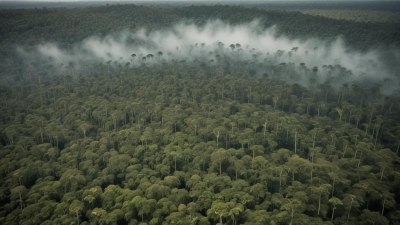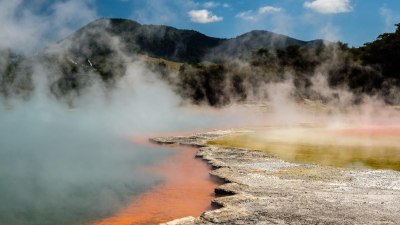How the Amazon Creates Its Own Weather (and Probably Its Own Mood Swings)
Explore how the Amazon rainforest influences weather patterns and its own ecological mood swings.

This image was created with the assistance of Freepik
The Amazon rainforest, often referred to as the lungs of the Earth, is a vast expanse of greenery that not only provides a habitat for diverse species but also profoundly influences the weather. In this article, we will explore the mechanisms through which the Amazon creates its own weather, examining the interactions between its dense vegetation, climate, and air dynamics.
One of the most significant aspects of the Amazon rainforest's influence on weather is the process of transpiration. Trees and plants release water vapor into the atmosphere through small openings in their leaves known as stomata. This release of moisture contributes to the humidity in the air and plays a crucial role in cloud formation. When the humidity in the atmosphere reaches a certain level, it can lead to the development of clouds and, eventually, precipitation.
The Amazon rainforest is responsible for producing approximately half of its own rainfall through this process. A study conducted showed that forests can recycle a significant amount of moisture back into the atmosphere. The transpired water eventually returns to the ground in the form of rain, creating a self-sustaining cycle that benefits both the forest and its climate.
Rainforest Microclimates
Moreover, the Amazon's dense vegetation creates microclimates within the region. Various species of trees and plants have distinct requirements regarding light, moisture, and temperature. This biodiversity contributes to different microclimates, which can influence local weather conditions. For instance, areas with thick canopies tend to have lower temperatures and higher humidity levels compared to open areas, leading to variations in rainfall patterns.
In contrast, deforestation and land conversion for agriculture disrupt these microclimates, resulting in changes in local weather patterns. When trees are removed, the moisture release decreases significantly, which affects cloud formation and rain. This alteration can lead to a vicious cycle where less rainfall results in drier conditions that further reduce vegetation, impacting the overall health of the ecosystem.
The Role of Heat and Currents
The Amazon rainforest not only generates moisture but also affects temperature. The dense foliage absorbs sunlight and provides shade, which can help moderate temperatures within the forest and its surroundings. This phenomenon is particularly crucial during hot seasons, where the vegetation helps maintain cooler microclimates. However, when deforestation occurs, the absence of trees means less shade and increased temperatures, contributing to heat waves that further stress the ecosystem.
In addition to temperature regulation, the Amazon affects atmospheric circulation. The heat generated from the forest influences the movement of air masses. Warm air rises, creating low-pressure systems that encourage airflow from surrounding areas. The shifting air patterns can disperse moisture-laden winds across vast distances, meaning that weather systems influenced by the Amazon can impact regions far beyond the forest itself.
The Interconnected Web of Climate Systems
One might wonder how localized phenomena in the Amazon can influence global weather patterns. The answer lies in the interconnected nature of climate systems. When the Amazon experiences fluctuations in weather, such as droughts or excessive rainfall, it can significantly impact the broader climate. For instance, dry conditions can lead to wildfires, releasing copious amounts of carbon dioxide into the atmosphere, while excessive rainfall can lead to flooding, altering river systems and affecting regional biodiversity.
El Niño and La Niña events are prime examples of how phenomena in the Pacific Ocean can influence the Amazon's weather. These oceanic patterns can result in altered precipitation levels in the region. For example, during an El Niño event, warmer surface waters can lead to intensified drought conditions in the Amazon, while La Niña often brings wetter conditions. The Amazon's interaction with these larger climatic patterns highlights the delicate balance within Earth's ecological systems.
The Feedback Loop of Mood Swings
As we delve deeper into the Amazon's influence on its own weather, it becomes apparent that the rainforest may experience what can be described as 'mood swings.' Drought periods can lead to stress in the vegetation, resulting in reduced growth and resilience. Conversely, periods of abundant rainfall can trigger growth spurts, allowing the forest to flourish. These fluctuations can have cascading effects on the entire ecosystem, from plant health to animal behavior.
In times of drought, trees may shed leaves to conserve water, affecting the habitat for numerous species. On the other hand, heavy rains can lead to increased growth of vegetation, providing ample food and shelter for wildlife. However, such changes can also make the forest more susceptible to pests and diseases, creating a balance that the ecosystem must navigate carefully.
Impact of Climate Change
The looming threat of climate change introduces additional uncertainties to the Amazon's weather patterns. Rising global temperatures can alter precipitation patterns, leading to more frequent and severe droughts or floods. The loss of biodiversity is also a significant concern, as the unique relationships between species may shift, making the ecosystem less resilient.
Moreover, human-induced deforestation exacerbates these climate challenges. The Amazon, already under stress from agriculture and logging, faces further threats that can lead to an alteration in its natural weather-generating capabilities. Protecting this crucial ecosystem from deforestation and degradation is vital to maintaining not only the weather patterns it has influenced for millennia but also the overall health of the planet.
Preserving the Amazon's Weather Machine
Efforts to conserve the Amazon rainforest are essential in mitigating the effects of climate change and preserving its unique weather-generating capabilities. Initiatives aimed at reforestation, sustainable land management, and stricter regulations on logging and agriculture can help restore balance within the forest, allowing it to continue playing its critical role in global weather patterns.
Scientific research and monitoring are also essential to understanding the intricate interactions between the Amazon and climate. By studying the dynamics of moisture recycling, temperature regulation, and atmospheric influences, researchers can inform policies that promote conservation and restoration efforts.
In conclusion, the Amazon rainforest is a remarkable natural phenomenon that generates its own weather and contributes to broader climatic patterns. By understanding and preserving this interconnected system, we can better navigate the challenges posed by climate change and protect not only the Amazon but also the health of our planet as a whole.











